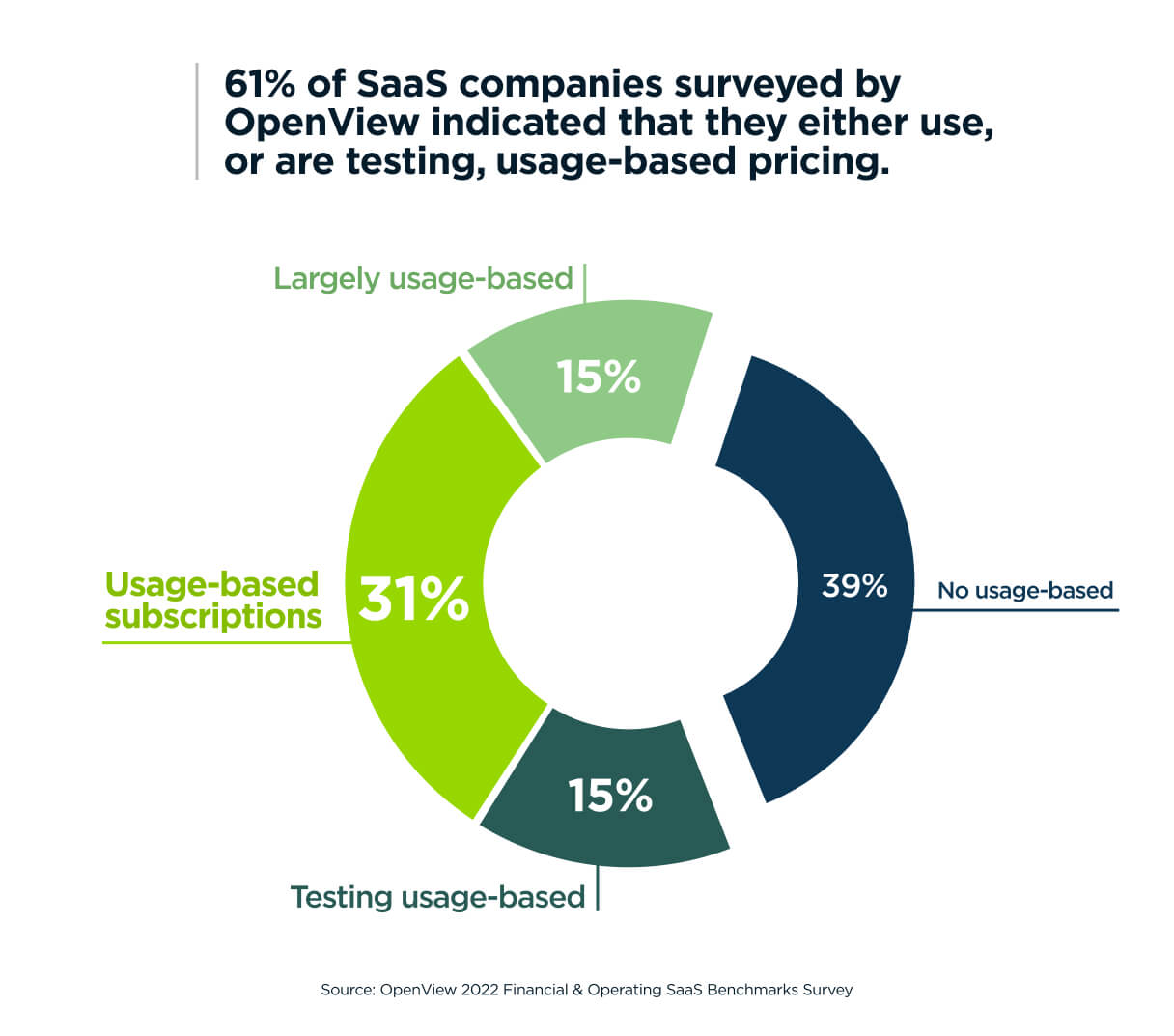In recent years, usage-based pricing in tech has emerged as a strong contender to SaaS (Software-as-a-Service). For many, this instigated the question: “which is right for me, SaaS or Usage-Based pricing?” Given pricing is the most impactful lever for value creation, choosing the right model is mission-critical. Which pricing model is right for your company?
First, let’s begin with a primer on the core attributes of each model to ensure we’re using common definitions:
Usage-Based Pricing vs. SaaS Pricing
SaaS (Software-as-a-Service) is a subscription-based pricing model that charges customers a fee to access and use software applications online. The software is hosted by the provider, and customers pay a recurring fee, usually on a monthly or annual basis. The fee typically covers the software license, maintenance, and support services, and is based on the quantity provided across these categories.
Usage-based pricing is a pricing model in which customers are charged based on their usage of a product or service rather than a fixed price. This option works best when usage is variable. A key decision to make in this model is what meter (i.e., the metric used to calculate usage) to use as the basis for pricing. The chosen metric should be readily measurable and well-understood by customers.
Now that we have a foundational understanding of each pricing model, let’s assess their respective advantages and disadvantages:
SaaS Pricing
Pros:
- Predictability: For the company, SaaS pricing provides a stable, predictable revenue stream which makes it easier to plan for future growth and investment. Budgeting is easier as customers know exactly what they will be paying.
- Simplicity: SaaS pricing typically has a simple pricing structure, which makes it easy for customers to understand and compare different software options.
Cons:
- Revenue potential: SaaS pricing can limit revenue upside because customers are only paying for a fixed set of features and services. Growth requires cross-selling additional features, if available, or penetrating additional business units.
- Customer churn: Some customers may not use the software enough to justify the fee, so they cancel their subscription.
Usage-Based Pricing
Pros:
- Aligned to perceived value: Usage-based pricing aligns revenue with usage, which means customers only pay for what they need.
- Revenue potential: There is no upper bound to a customer’s revenue potential. The more often the software is used, the more the company will make.
- Flexibility: Customer retention is often higher because customers pay less when the software is used less. This significantly reduces the likelihood of cancellation in slow months.
Cons:
- Predictability: The company’s revenue is subject to fluctuations based on customer usage. Over time, an observable pattern may emerge which helps, but is not ultimately guaranteed to occur year-over-year.
- Transparency: It can be difficult for customers to understand the pricing meter, and meters vary across solutions making it harder to compare software options.
- Difficult to budget: For customers, budgeting can be difficult as usage is unknown until the end of the month.
In addition to its use cases, usage-based pricing has significant organizational requirements for successful implementation. Below is a checklist of enabling capabilities:
- Technology infrastructure: Robust data collection is necessary, which may imply changes to the existing infrastructure and/or the adoption of new technologies.
- Analytical capabilities: Track usage at a granular level to enable the customer success function.
- Payment processing: Accurately calculate and process charges based on the available usage data. This may require integration with a payment gateway or other third-party service provider.
- Sales & Marketing: Renewed training to convey the product’s value proposition to enable value selling and marketing efforts.
- Sales compensation: Aligning sales compensation to the consumption model requires a meaningful shift to the comp plan design. Variable sales compensation should be informed by activity beyond the initial sale in order to realize the long-term potential of this model. To do so, consumption-based sales performance metrics are required.
- Pricing strategy: Pricing needs to dovetail into the top-of-funnel marketing motion to convey the benefits and alignment to customer value drivers. This may require a revisit to buyer personas, customer segments, and competitive price positioning.
The Hybrid Model
By now, hopefully two things are clear. First, SaaS and usage-based pricing have a seemingly inverse relationship—the pros of one overlap with the cons of the other, and vice versa. Second, the underlying capabilities required of each model are fundamentally different.
So, what does this mean for our central question “which is right for me, SaaS or Usage-Based pricing?” It means that this either/or decision is a fallacy. In fact, for many organizations, a hybrid model is the right approach.
Hybrid models have several distinct advantages, including:
- It encourages you to effectively segment your business—a core feature of high-performing pricing teams—and align each model to the segment’s value drivers.
- It reduces the magnitude of organizational change required to support usage-based pricing. At a time when so much change is already occurring, this can be a big benefit.
- It provides a built-in piloting opportunity. If usage-based pricing turns out not to be a long-term fit, this aids in the reversibility of the change. If it is a long-term fit, you have in-house experts who can support a future deployment across the rest of the business.
How does this work? One example of a hybrid model would be a software company charging a monthly fixed fee based on the number of users, and usage is capped by a preset limit. This limit can be “hard,” where usage is throttled until the customer upgrades to a higher tier. This limit can also be “soft,” where customers are charged additional usage-based fees above the usage limit.
Schedule a discovery call with me to discuss how Cortado can help to increase value creation in your portcos through pricing and GTM strategy.





